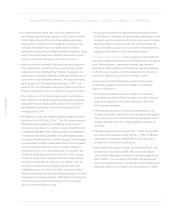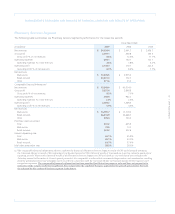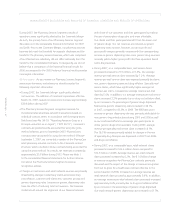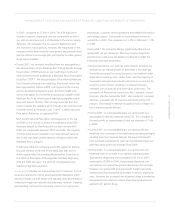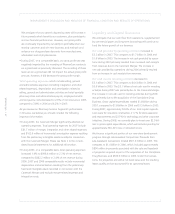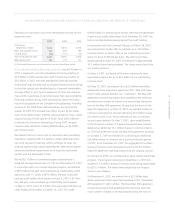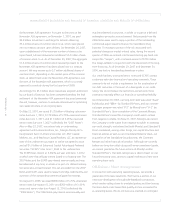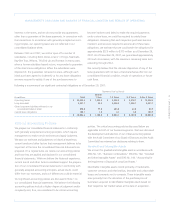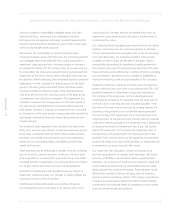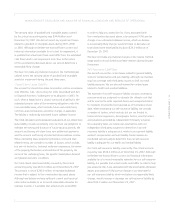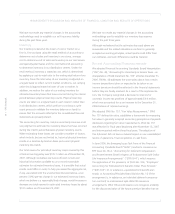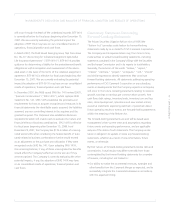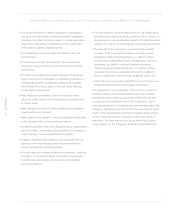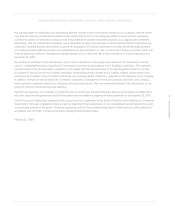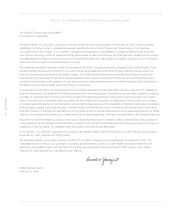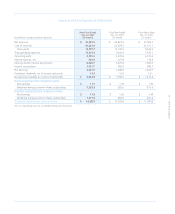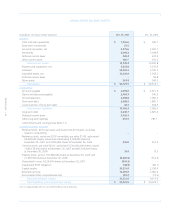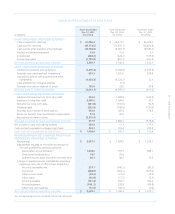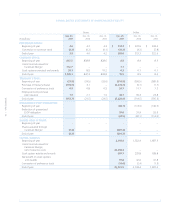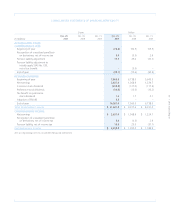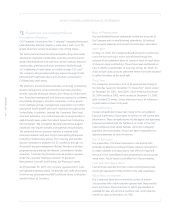CVS 2007 Annual Report Download - page 38
Download and view the complete annual report
Please find page 38 of the 2007 CVS annual report below. You can navigate through the pages in the report by either clicking on the pages listed below, or by using the keyword search tool below to find specific information within the annual report.
34 I CVS Caremark
We have not made any material changes in the accounting
methodology used to establish our self-insurance liability
during the past three years.
Inventory
Our inventory is stated at the lower of cost or market on a
first-in, first-out basis using the retail method of accounting to
determine cost of sales and inventory in our stores, average
cost to determine cost of sales and inventory in our mail service
and specialty pharmacies and the cost method of accounting
to determine inventory in our distribution centers. Under the
retail method, inventory is stated at cost, which is determined
by applying a cost-to-retail ratio to the ending retail value of our
inventory. Since the retail value of our inventory is adjusted on
a regular basis to reflect current market conditions, our carrying
value should approximate the lower of cost or market. In
addition, we reduce the value of our ending inventory for
estimated inventory losses that have occurred during the interim
period between physical inventory counts. Physical inventory
counts are taken on a regular basis in each location (other than
in six distribution centers, which perform a continuous cycle
count process to validate the inventory balance on hand) to
ensure that the amounts reflected in the consolidated financial
statements are properly stated.
The accounting for inventory contains uncertainty since we must
use judgment to estimate the inventory losses that have occurred
during the interim period between physical inventory counts.
When estimating these losses, we consider a number of factors,
which include, but are not limited to, historical physical inventory
results on a location-by-location basis and current physical
inventory loss trends.
Our total reserve for estimated inventory losses covered by this
critical accounting policy was $135.1 million as of December 29,
2007. Although we believe we have sufficient current and
historical information available to us to record reasonable
estimates for estimated inventory losses, it is possible that actual
results could differ. In order to help you assess the aggregate risk,
if any, associated with the uncertainties discussed above, a ten
percent (10%) pre-tax change in our estimated inventory losses,
which we believe is a reasonably likely change, would increase or
decrease our total reserve for estimated inventory losses by about
$13.5 million as of December 29, 2007.
We have not made any material changes in the accounting
methodology used to establish our inventory loss reserves
during the past three years.
Although we believe that the estimates discussed above are
reasonable and the related calculations conform to generally
accepted accounting principles, actual results could differ from
our estimates, and such differences could be material.
Recent Accounting Pronouncements
We adopted Financial Accounting Standards Board Interpretation
(“FIN”) No. 48, “Accounting for Uncertainty in Income Taxes – an
interpretation of FASB Statement No. 109” effective December 31,
2006. FIN No. 48 addresses the uncertainty about how certain
income tax positions taken or expected to be taken on an
income tax return should be reflected in the financial statements
before they are finally resolved. As a result of the implementa-
tion, the Company recognized a decrease to reserves for
uncertain income tax positions of approximately $4.0 million,
which was accounted for as an increase to the December 31,
2006 balance of retained earnings.
We adopted SFAS No. 157, “Fair Value Measurement.” SFAS
No. 157 defines fair value, establishes a framework for measuring
fair value in generally accepted accounting principles and expands
disclosures regarding fair value measurements. SFAS No. 157
was effective for fiscal years beginning after November 15, 2007
and interim periods within those fiscal years. The adoption of
this statement did not have a material impact on our consolidated
results of operations, financial position or cash flows.
In June 2006, the Emerging Issues Task Force of the Financial
Accounting Standards Board (“FASB”) reached a consensus on
EITF Issue No. 06-4, “Accounting for Deferred Compensation
and Postretirement Benefit Aspects of Endorsement Split-Dollar
Life Insurance Arrangements” (“EITF 06-4”), which requires
the application of the provisions of SFAS No. 106, “Employers’
Accounting for Postretirement Benefits Other Than Pensions”
(“SFAS 106”) (if, in substance, a postretirement benefit plan
exists), or Accounting Principles Board Opinion No. 12 (if the
arrangement is, in substance, an individual deferred compensa-
tion contract) to endorsement split-dollar life insurance
arrangements. SFAS 106 would require us to recognize a liability
for the discounted value of the future premium benefits that we


